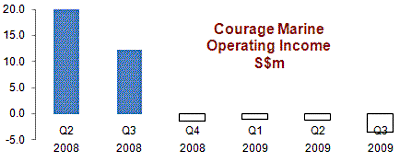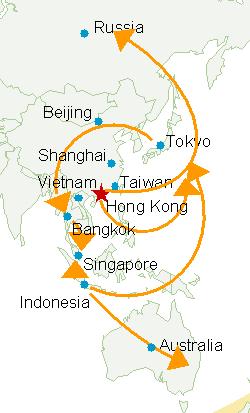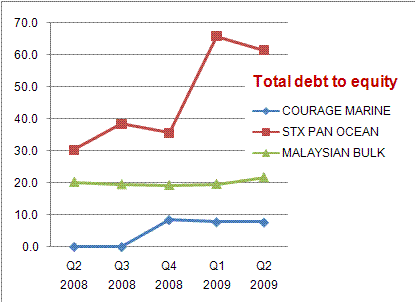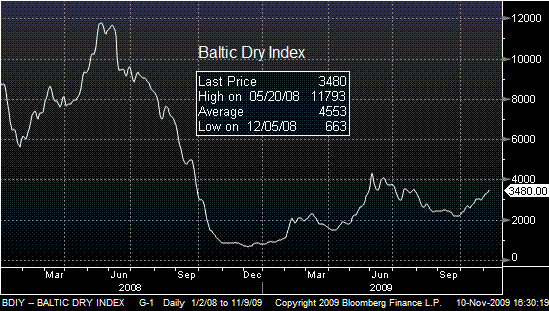
THE SECTOR OUTLOOK for dry bulk shippers such as Courage Marine draws mixed views from analysts.
But sometimes, bargains for cyclical stocks are found when the outlook is most uncertain.
From net earnings of US$8.6 million in 3Q08, Courage Marine suffered 4 quarters of losses as international trade came to a standstill following a freeze in trade financing.
Its spot voyage business had enjoyed the highs of the dry bulk shipping market, but it got hit hard during the sharp downcycle.
Courage Marine has 8 bulk carriers plying Asian trading routes, including from Australia all the way to Russia. Some 65% of its cargo in FY08 comprised of coal, mainly used for producing electricity and for smelting iron into steel.
Freight rates and revenues for dry bulk carrier operators are determined by global supply and demand for the commodities they ship. These commodities include building materials, coal, metallic ores, and grains."

Bulls like CIMB-GK analyst Raymond Yap point out that demand for bulk carriers is now boosted by China and India’s infrastructure projects.
For Courage Marine, shipments to China are important, due to the country's huge imports of iron ore from Australia (world’s second largest iron ore producer after China).
Four weeks ago, on 23 Oct, Mr Yap upped his forecast of the Baltic Dry Index (BDI) to 3,500 points, citing a strong recovery in global steel demand.
From 2,300 points in late Sep, the index has swept past the CIMB-GK forecast, and closed at 3,615 on 10 Nov.

Others, like DBS Vickers’ Chong Wee Lee, caution that freight rates for dry bulk carriers will remain weak due to a vessel capacity glut. The analyst projects a 7.3% year-on-year increase of fleet size for 2009.
Detractors say the BDI’s recovery is a flash in the pan, and that the index will falter after the Christmas preparation season (Aug-Nov) when suppliers step up shipments of raw materials to manufacturers.
While Courage Marine’s chairman, Mr Hsu Chih-chien, does not expect a quick earnings recovery, he is sure-footed when it comes to navigating a shipping downturn.
About 70% of group revenues are from spot voyage contracts – contract fixtures are for single voyages of 2 to 4 weeks, and freight rates are much more volatile, depending on the spot market.
To lower income volatility, a third of the business is in contracts of affreightment (COA).
In COA, the vessel owner is obliged to transport a pre-determined cargo load within a stipulated period of, say, 12 to 24 months. Large receivers like steel mills or grain traders usually use COA.
Mr Hsu’s unique business strategy is quite unlike most other Hong Kong shipping companies.
During the recent boom, many ship-owners were so eager to lock in long-term time charters (10 to 15 years) when freight rates were high, they paid through their nose for newbuildings.
In reality, when markets plunge, some charterers come a begging for lower charter rates. Shipowners will be under pressure to lower charter rates, even while shouldering high bank loans.
A time charter is like vehicle lease - the customer handles all commercial aspects of the entire vessel, and the vessel owner only handles crewing at a freight rate that is fixed for the lease period.
Courage Marine |
|
| Stock price | 18 cts |
| Net asset value | 14 cts a share |
| Gearing | 6.8% |
| Market capitalisation | S$190.6 million |
A ship-owner’s income stream may appear least risky when he secures long term charters, but Mr Hsu points out that lured by high freight rates, many ship owners have chained themselves to heavy capital expenditure financing burden.
Mr Hsu likes COA as it offers more exposure to market up-cycles than long-term time charters. The risk to COA shippers is not being able to hire vessels at a low cost when markets take off.
Mr Hsu prefers to acquire vessels at rock bottom prices.

That’s how Courage Marine has kept its balance sheet debt-free through most years, which is unheard of among shipping companies.
For example, the bulk carrier operator purchased in Oct 2008 a 24-year old Panamax bulk carrier for US$3.75 million. Just 2 months earlier in Aug, the seller was asking for US$30 million, said the management.
Such a strategy takes discipline and experience, said Mr Hsu.
This is because prices of second hand vessels are even more volatile than for newbuildings, given the former’s ability to generate immediate lease income, compared to waiting 1 to 2 years for a newbuilding to be delivered.
The second unique aspect of Courage Marine is low capital cost.
Since inception in 2000, it has specialized in operating older vessels (average fleet age is now 25 yrs old).
25 years is high. While there is no IMO rule on this, ship owners typically demolish a vessel by the time it reaches 25 to 30 years of age. By that age, maintenance costs would have become so high it is no longer commercially viable to operate.
Thanks to the company’s 5 directors, each an industry veteran in his own right with over 20 years of experience, its vessels, though old, are seldom in repair.
The management’s experience has allowed it to operate older ships profitably.
The amazing thing about Courage’s aged fleet is this: utilization has always been well over 90%, a rare feat even among competitors with fleet age less than half, said Mr Hsu.
The only exception was in 2009, when utilization was 65%.






